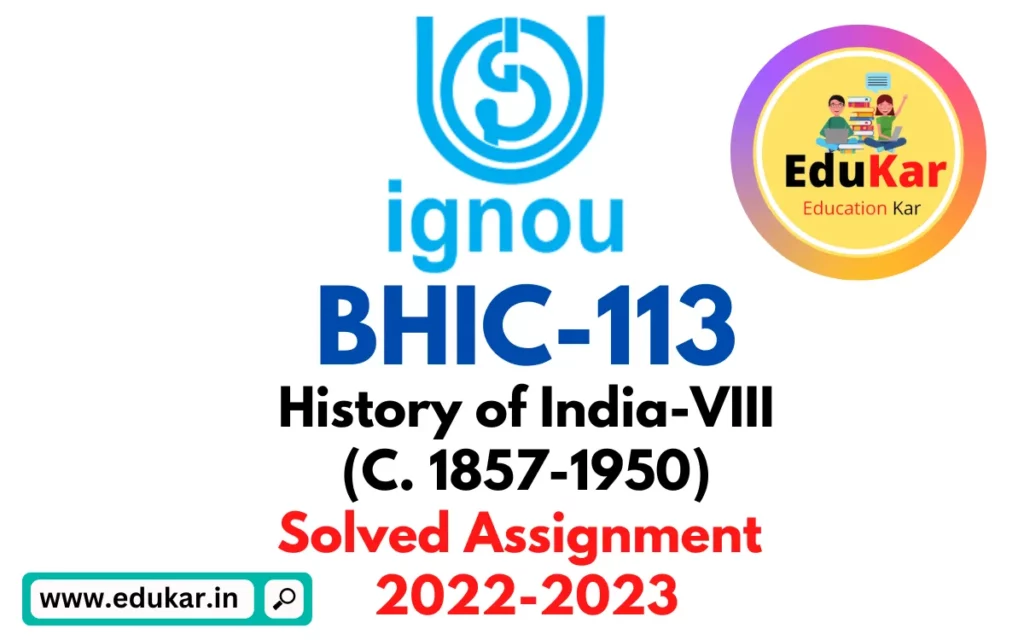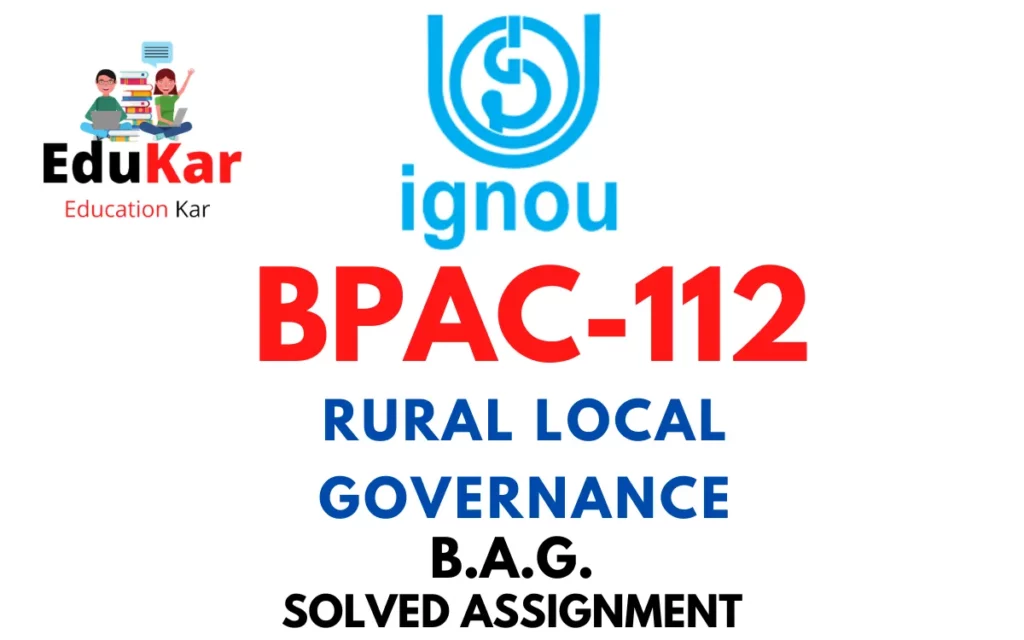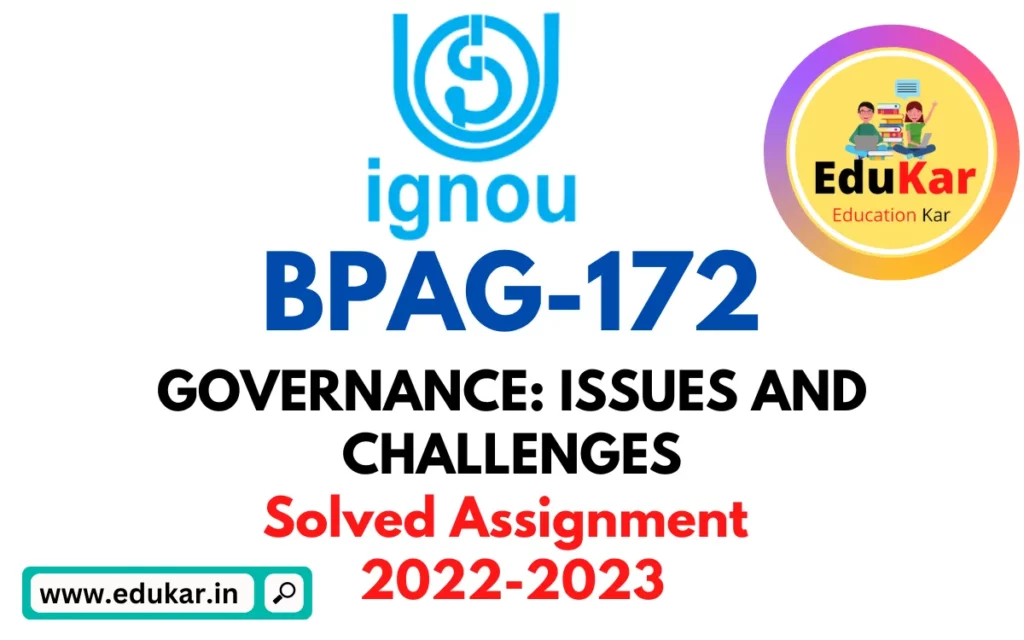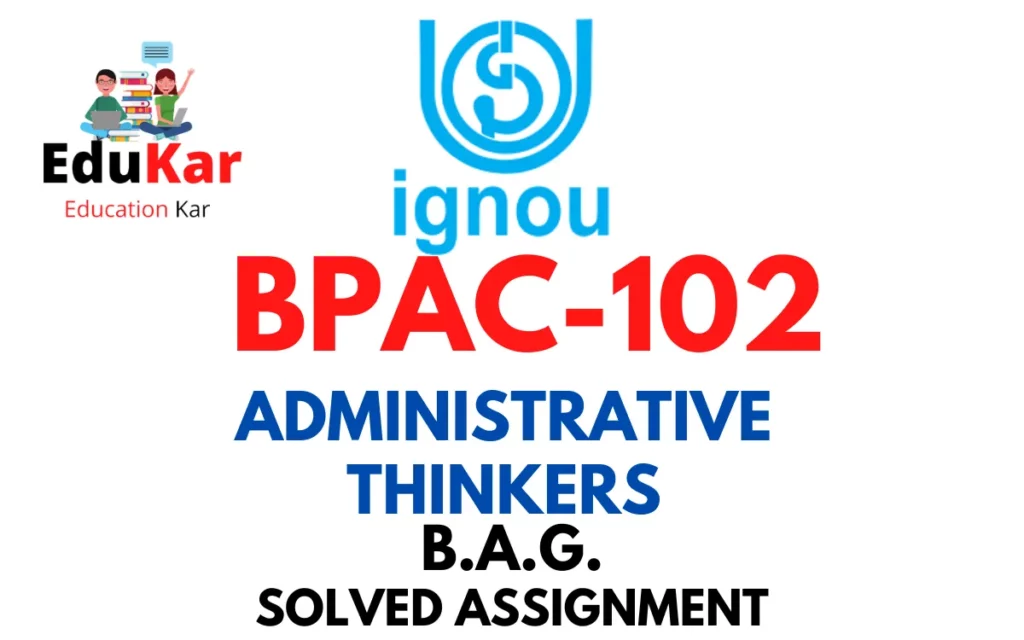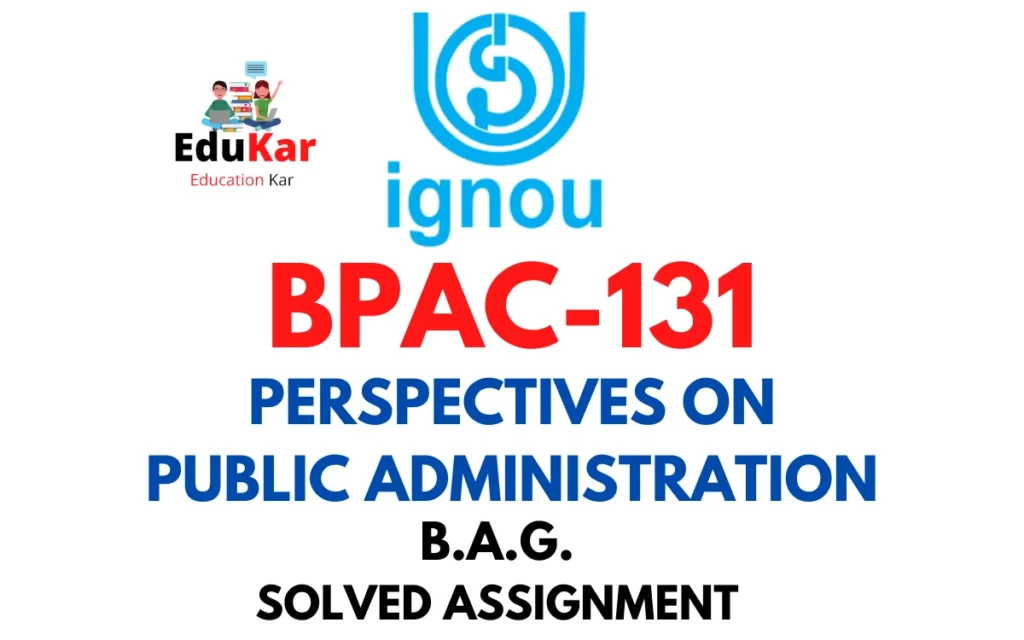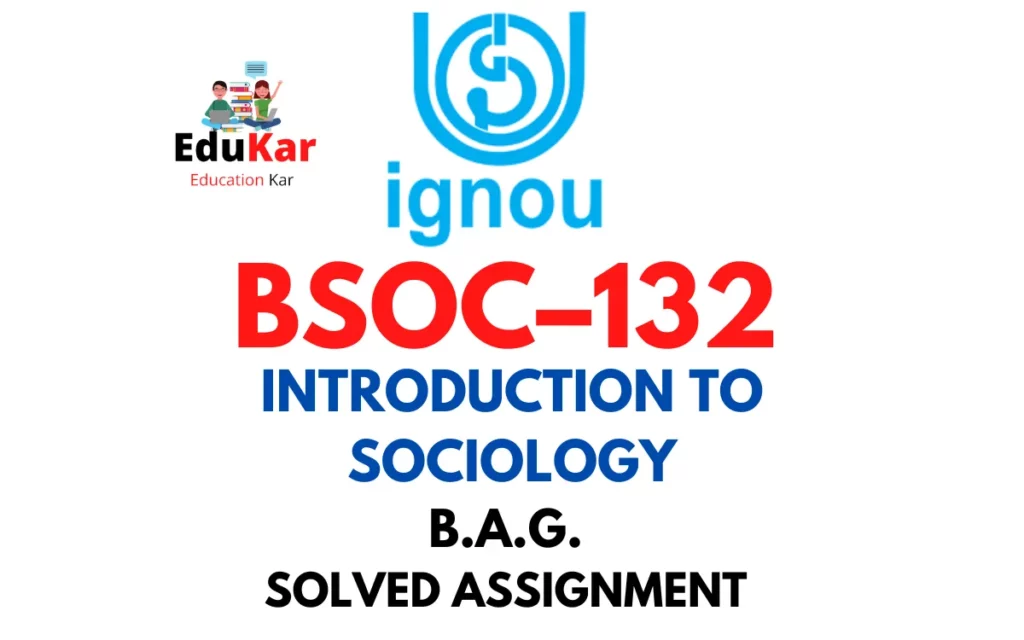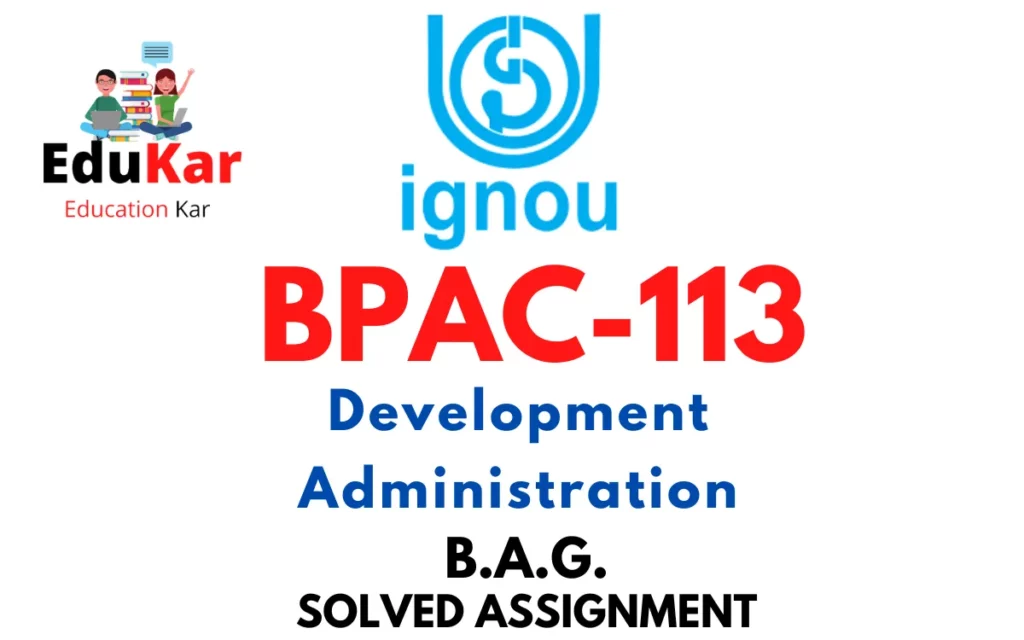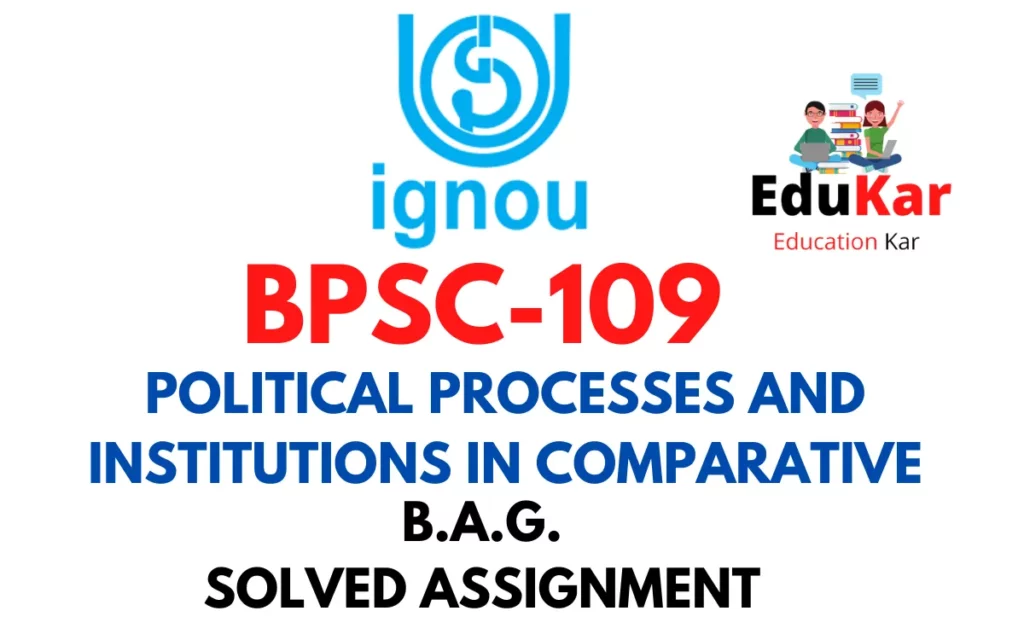Contents
- 1 Assignment – I
- 2 Answer the following in about 500 words each.
- 3 1. Discuss the evolution of local Self-government in India.
- 4 2. Examine the relationship between the federal government and sub-regional autonomy movements in India.
- 5 Assignment – II
- 6 Answer the following questions in about 250 words each.
- 7 1. Examine the relationship between migration and globalization.
- 8 2. Explain the various approaches to the study of state politics in India.
- 9 3. Discuss the political ideology of Dravida Munnetra Kazhagam (DMK) Party.
- 10 Assignment – III
- 11 Answer the following questions in about 100 words each.
- 12 1. Write a brief note on Chipko Movement.
- 13 2. Explain the Residuary powers of legislation.
- 14 3. Briefly discuss the Punjab Model of Development.
- 15 4. Discuss the Kerala Model of Development.
- 16 5. Write a brief note on the Marxian framework.

| Title | BPSE-143: IGNOU BAG Solved Assignment 2022-2023 (STATE POLITICS IN INDIA) |
| University | IGNOU |
| Degree | Bachelor Degree Programme |
| Course Code | BPSE-143 |
| Course Name | STATE POLITICS IN INDIA |
| Programme Name | Bachelor of Arts (General) |
| Programme Code | BAG |
| Total Marks | 100 |
| Year | 2022-2023 |
| Language | English |
| Assignment Code | BPSE-143/ASST/TMA/2022-23 |
| Last Date for Submission of Assignment: | For June Examination: 31st April For December Examination: 30th September |

Assignment – I
Answer the following in about 500 words each.
1. Discuss the evolution of local Self-government in India.
Ans:
The evolution of local self-government in India can be traced back to the colonial era, where British administrators introduced the concept of local governance as a means of indirect rule. The first steps towards local self-government were taken through the creation of municipal corporations in cities, which were granted a certain degree of autonomy and allowed to levy taxes.
After independence, the Indian Constitution provided for the establishment of Panchayati Raj institutions (PRIs) as a form of local self-government in rural areas. The PRIs were initially created as advisory bodies, but with the passage of the Panchayat Raj Act in 1992, they were granted constitutional recognition and expanded powers. The act provided for the establishment of three tiers of Panchayats, including the Gram Panchayat at the village level, the Intermediate Panchayat at the block level, and the Zilla Parishad at the district level.
However, the implementation of PRIs was uneven across states, with some states showing a stronger commitment to decentralization than others. To address this issue, the 73rd Amendment to the Constitution was passed in 1992, which made it mandatory for all states to establish Panchayati Raj institutions. The amendment also granted PRIs greater financial and administrative powers, making them an important instrument of local self-governance.
In recent years, there have been efforts to further strengthen local self-government in India, with a focus on improving the capacity of PRIs to deliver services and promote development. For example, the government has launched several schemes aimed at improving the financial sustainability of PRIs, such as the National Rural Employment Guarantee Scheme (NREGS) and the Mahatma Gandhi National Rural Employment Guarantee Act (MGNREGA).
In addition to PRIs, there have also been efforts to improve the functioning of municipal corporations, including the introduction of reforms aimed at increasing transparency and accountability in urban governance. For example, the 74th Amendment to the Constitution,
passed in 1992, provided for the establishment of urban local bodies, known as Nagar Panchayats, Municipalities and Municipal Corporations, with elected representatives and greater powers to tax and regulate local services. The amendment also provided for the constitution of ward committees, to represent the interests of individual neighborhoods within the city.
Overall, the evolution of local self-government in India has been marked by a gradual expansion of powers and responsibilities, as well as increased efforts to make local governance more accountable and responsive to the needs of the people. Despite these efforts, the implementation of local self-government remains a challenge in India, with issues of corruption, lack of transparency, and inadequate financial resources continuing to hamper its effectiveness. Nevertheless, the continued growth of local self-government in India remains an important aspect of the country’s democratic development, as it allows citizens to participate more directly in the decision-making process and promotes greater accountability in governance.
passed in 1992, provided for the establishment of urban local bodies, known as Nagar Panchayats, Municipalities and Municipal Corporations, with elected representatives and greater powers to tax and regulate local services. The amendment also provided for the constitution of ward committees, to represent the interests of individual neighborhoods within the city.
Overall, the evolution of local self-government in India has been marked by a gradual expansion of powers and responsibilities, as well as increased efforts to make local governance more accountable and responsive to the needs of the people. Despite these efforts, the implementation of local self-government remains a challenge in India, with issues of corruption, lack of transparency, and inadequate financial resources continuing to hamper its effectiveness. Nevertheless, the continued growth of local self-government in India remains an important aspect of the country’s democratic development, as it allows citizens to participate more directly in the decision-making process and promotes greater accountability in governance.
2. Examine the relationship between the federal government and sub-regional autonomy movements in India.
Ans: The relationship between the federal government and sub-regional autonomy movements in India has been complex and multifaceted. The Indian Constitution established a federal system of government, with powers divided between the central government and the states. However, over the years, several regions within the country have sought greater autonomy, leading to a number of conflicts between the central government and sub-regional autonomy movements.
One of the most notable examples of this conflict is the movement for greater autonomy in the state of Nagaland. The Nagas, who have a distinct cultural and ethnic identity, have been demanding greater autonomy since the 1950s. The central government has attempted to address these demands through a number of peace accords and agreements, but these have not been successful in resolving the conflict. The central government has also used force to suppress the movement, leading to further tensions and resentment.
Similarly, the state of Kashmir has seen a long-standing conflict over the issue of autonomy. The Kashmiri people have a distinct cultural and religious identity and have sought greater autonomy for many years. The central government has responded with a mix of force and negotiation, but the conflict continues to this day.
Another example of a sub-regional autonomy movement is the movement for a separate state of Telangana in the southern region of India. The Telangana region has a distinct cultural and linguistic identity, and the movement for a separate state has been fueled by perceived economic and political neglect by the central government. The central government has responded by granting the region the status of a separate state, but the issue remains a contentious one.
The central government has also been faced with demands for greater autonomy from various tribal groups across the country. These groups have sought greater control over their lands and resources, as well as greater cultural and political representation. The central government has responded to these demands through a mix of negotiation and force, but the issues remain unresolved in many cases.
Assignment – II
Answer the following questions in about 250 words each.
1. Examine the relationship between migration and globalization.
Ans: Migration and globalization are interrelated phenomena that have profound impacts on individuals, communities, and societies. Migration refers to the movement of people from one place to another, and globalization refers to the integration of economies, societies, and cultures across the world through increased trade, communication, and transportation.
Migration is both a cause and effect of globalization. On one hand, globalization has created new opportunities and incentives for people to move to different countries in search of better economic prospects, education, or freedom from conflict and persecution. On the other hand, migration has also contributed to globalization by facilitating the spread of ideas, goods, and cultures across borders.
However, globalization has also brought about new challenges for migrants. The increased competition for jobs and services in destination countries has led to increased xenophobia and discrimination, and many migrants face challenges related to language, culture, and social integration. At the same time, globalization has made it easier for governments and employers to exploit migrant workers, who are often vulnerable because of their lack of legal rights and social protections.
2. Explain the various approaches to the study of state politics in India.
Ans: The study of state politics in India is a complex and multifaceted field that involves various approaches and perspectives. Some of the key approaches to the study of state politics in India are as follows:
- Comparative Federalism: This approach focuses on comparing the political, administrative, and financial arrangements between the central government and the state governments in India. It examines the division of powers and responsibilities between the two levels of government and how these are implemented in practice.
- Political Economy: This approach views the Indian state as a site of power and conflict, where different groups compete for resources and influence. It analyses the distribution of wealth, income, and power between different social classes and the impact of state policies on these distributions.
- Political Sociology: This approach focuses on the social, cultural, and historical dimensions of Indian state politics. It examines the role of social movements, interest groups, and civil society organizations in shaping state policies and practices.
- Historical Institutionalism: This approach looks at the historical evolution of Indian state politics, tracing the development of institutions, laws, and political arrangements over time. It highlights the role of historical events and actors in shaping the current political landscape.
- Elite Theory: This approach focuses on the role of elites, such as politicians, bureaucrats, and business leaders, in shaping state politics in India. It analyses the strategies and power relations among these groups and their impact on public policy and administration.
- Political Culture: This approach examines the cultural and ideological dimensions of state politics in India. It analyses the beliefs, values, and norms that shape political behavior and the role of cultural factors in shaping political attitudes and preferences.
3. Discuss the political ideology of Dravida Munnetra Kazhagam (DMK) Party.
Ans: Dravida Munnetra Kazhagam (DMK) is a regional political party in the Indian state of Tamil Nadu. The party’s political ideology is centered around the concept of Dravidianism, which emphasizes the cultural and linguistic distinctiveness of the people of South India, especially Tamil Nadu.
The party was founded in 1949 by C. N. Annadurai, who was a key figure in the Dravidian movement, which sought to challenge the dominance of the Brahmin community in Tamil Nadu and to promote the rights of non-Brahmin communities. The DMK adopted the Dravidian ideology and sought to establish a separate Dravidian identity for the people of Tamil Nadu.
The party’s political agenda is centered around social justice, equality, and regional autonomy. The DMK has consistently advocated for the rights of the backward classes, women, and minorities, and has sought to promote their economic and social development. The party has also been a strong supporter of regional autonomy, advocating for the decentralization of power and the devolution of more powers to the state governments.
The DMK has been critical of the central government and the policies of the Congress Party, which it sees as representing the interests of the northern, Hindi-speaking states. The party has sought to promote the interests of Tamil Nadu and the southern states, and has advocated for the protection of the rights of the southern states in the Indian federation.
Assignment – III
Answer the following questions in about 100 words each.
1. Write a brief note on Chipko Movement.
Ans: The Chipko Movement was a forest conservation movement that started in the Indian state of Uttarakhand (formerly part of Uttar Pradesh) in 1973. It was an early example of environmental direct action, in which villagers hugged trees to protect them from being felled by contractors. The movement was led by environmental activist Sundarlal Bahuguna, who advocated for the rights of local communities and the protection of their forests and resources. The success of the Chipko Movement led to the creation of the Forest Conservation Act in 1980, which gave greater protection to forests and the rights of local communities. The movement also inspired similar environmental movements around the world and is considered a landmark in the history of environmental activism.
2. Explain the Residuary powers of legislation.
Ans: Residuary powers of legislation refer to the powers that are not specifically assigned to either the central government or the state governments in a federal system of government. These powers fall under the jurisdiction of the central government and are usually defined as “residual” or “leftover” powers. In India, the residuary powers of legislation are defined in Article 248 of the Constitution and fall under the jurisdiction of Parliament. This means that if a matter is not specifically mentioned in the list of powers given to the states or to the central government, it falls under the purview of the central government and can be regulated by Parliament. These powers include matters such as criminal law, defense, foreign affairs, and currency. The allocation of residuary powers helps to ensure that the central government has the necessary powers to address national level issues, while also allowing for a degree of decentralization to the states.
3. Briefly discuss the Punjab Model of Development.
Ans: The Punjab Model of Development refers to the economic development and growth that has taken place in the Indian state of Punjab. The state is known for its high levels of agricultural production, as well as its strong industrial base and growing service sector.
The Punjab Model of Development is characterized by a focus on agriculture, with the state’s economy being largely based on the production of crops such as wheat and rice. The state has a well-developed network of irrigation systems, which have helped to support the growth of agriculture in the region. In addition, the state has a strong industrial base, with a growing manufacturing sector and a growing service sector, particularly in the areas of finance, technology, and tourism.
One of the key features of the Punjab Model of Development is the focus on human development, with the state investing heavily in education and health. The state has a well-educated population, with a high level of literacy and a strong tradition of political activism. The state’s social development has been driven by a combination of government policies and grassroots movements, particularly in the areas of education and health.
The Punjab Model of Development has also been characterized by a focus on innovation and entrepreneurship, with the state’s economy being driven by a combination of small and medium-sized enterprises, as well as large corporations. The state has a well-developed infrastructure, including a strong transportation network, which has helped to support economic growth and development.
4. Discuss the Kerala Model of Development.
Ans: The Kerala Model of Development refers to the unique pattern of social and economic development that has taken place in the Indian state of Kerala. The state is known for its high levels of human development, particularly in terms of literacy, life expectancy, and access to health care.
The Kerala Model is characterized by a strong public sector, a well-developed network of social services, and high levels of public investment in education and health. The state has a high level of political consciousness and a tradition of social activism, which has helped to create a strong civil society and a vibrant culture of public participation.
One of the key features of the Kerala Model is the emphasis on human development, rather than just economic growth. The state has a well-educated population, with a high level of literacy and a strong tradition of political activism. The state’s social development has been driven by a combination of government policies and grassroots movements, particularly in the areas of education, health, and the environment.
The Kerala Model has also been characterized by a strong tradition of collective action and cooperative ventures, which have helped to promote economic development in the state. The state has a well-developed network of cooperatives, including producer cooperatives, credit cooperatives, and consumer cooperatives, which have helped to promote economic empowerment and reduce poverty.
5. Write a brief note on the Marxian framework.
Ans: The Marxian framework is a social, economic, and political theory based on the ideas of the German philosopher and economist Karl Marx. It critiques capitalism, argues for the abolition of private property, and advocates for a socialist society in which the means of production are owned and controlled collectively. The Marxian framework views history as a series of class struggles, with the ruling class exploiting the working class. It argues that the exploitation of labor leads to increasing inequality and the concentration of wealth in the hands of a few, which in turn leads to social and political conflicts. The ultimate goal of the Marxian framework is to create a classless society in which everyone has equal access to resources and opportunities. The Marxian framework has had a major impact on modern political and economic thought, and continues to be influential in the fields of sociology, economics, and political science.
How to Download BPSE-143 Solved Assignment?
You can download it from the www.edukar.in, they have a big database for all the IGNOU solved assignments.
Is the BPSE-143 Solved Assignment Free?
Yes this is absolutely free to download the solved assignment from www.edukar.in
What is the last submission date for BPSE-143 Assignment?
For June Examination: 31st April, For December Examination: 30th October



